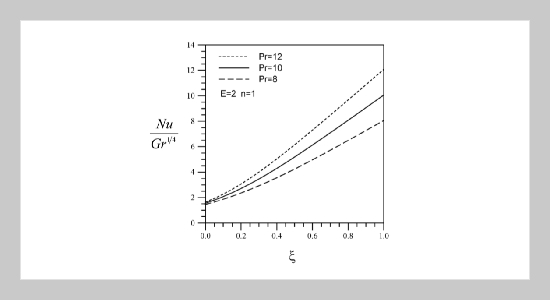REFERENCES
- [1] Gray, J., Kassory, D. R. and Tadjeran, H., “The Effect of Significant Viscosity Variation on Convective Heat Transport in Water-Saturated Porous Media,” J. Fluid Mech., Vol. 117, pp. 233 249 (1982). doi: 10.1017/ S0022112082001608
- [2] Lings, J. X. and Dybbs, A., “Forced Convection Over a Flat Plate Submersed in a Porous Medium: Variable Viscosity Case,” Paper 87-WA/HT-23, ASME, New York (1987).
- [3] Kafoussius, N. G. and Williams, E. M., “The Effect of Temperature Dependent Viscosity on the Free Convective Laminar Boundary Layer Flow Past a Vertical Isothermal Plate,” Acta Mech., Vol. 110, pp. 123 137 (1995). doi: 10.1007/BF01215420
- [4] Kafoussius, N. G. and Rees, D. A. S., “Numerical Study of the Combined Free and Forced Convective Laminar Boundary Layer Flow Past a Vertical Isothermal Flat Plate with Temperature Dependent Viscosity,” Acta Mech., Vol. 127, pp. 39 50 (1998). doi: 10.1007/ BF01170361
- [5] Molla, M. M., Hossain, M. A. and Gorla, R. S. R., “Natural Convection Flow from an Isothermal Circular Cylinder with Temperature Dependent Viscosity,” Heat Mass Transfer, Vol. 41, pp. 594 598 (2005). doi: 10.1007/s00231-004-0576-7
- [6] Cheng, C. Y., “Nonsimilar Boundary Layer Analysis of Double-Diffusive Convection from a Vertical Truncated Cone in a Porous Medium with Variable Viscosity,” Appl. Math. Comput., Vol. 212, pp. 185 193 (2009). doi: 10.1016/j.amc.2009.02.012
- [7] Pal, D. and Mondal, H., “Influence of TemperatureDependent Viscosity and Thermal Radiation on MHDForced Convection over a Non-Isothermal Wedge,” Appl. Math. Comput., Vol. 212, pp. 194 208 (2009). doi: 10.1016/j.amc.2009.02.013
- [8] Cheng, C. Y., “Natural Convection Boundary Layer Flow of Fluid with Temperature-Dependent Viscosity from a Horizontal Cylinder with Constant Surface Heat Flux,” Appl. Math. Comput., Vol. 217, pp. 83 91 (2010). doi: 10.1016/j.amc.2010.05.011
- [9] Hering, R. G. and Grosh, R. J., “Laminar Free Convectionfrom a Non-Isothermal Cone,” Int. J. Heat Mass Transfer, Vol. 5, pp. 1059 1068 (1962). doi: 10. 1016/0017-9310(62)90059-5
- [10] Na, T. Y. and Chiou, J. P., “Laminar Natural Convection Over a Frustum of a Cone,” Appl. Sci. Res.,Vol. 35, pp. 409 421 (1979). doi: 10.1007/BF00420389
- [11] Yih, K. A., “Effect of Radiation on Natural Convection about a Truncated Cone,” Int. J. Heat Mass Transfer, Vol. 42, pp. 4299 4305 (1999). doi: 10.1016/S0017- 9310(99)00092-7
- [12] Hossain, M. A. and Paul, S. C., “Free Convection from a Vertical Permeable Circular Cone with Non-Uniform Surface Temperature,” Acta Mech., Vol. 151, pp. 103 114 (2001). doi: 10.1007/BF01272528
- [13] Chamkha, A. J., “Coupled Heat and Mass Transfer by Natural Convection about a Truncated Cone in the Presence of Magnetic Field and Radiation Effects,” Num. Heat Transfer, Part A: Appl., Vol. 39, pp. 511 530 (2001). doi: 10.1080/10407780120202
- [14] Postelnicu, A., “Free Convection about a Vertical Frustum of a Cone in a MicropolarFluid,” Int. J. Eng. Sci., Vol. 44, pp. 672 682 (2006). doi: 10.1016/j.ijengsci. 2005.10.009
- [15] Cheng, C. Y., “Natural Convection of a Micropolar Fluid from a Vertical Truncated Cone with Power-Law Variation in Surface Temperature,” Int. Comm. Heat Mass Transfer, Vol. 35, pp. 39 46 (2008). doi: 10. 1016/j.icheatmasstransfer.2007.05.018
- [16] Cheng, C. Y., “Natural Convection Boundary Layer Flow of a Micropolar Fluid Over a Vertical Permeable Cone with Variable Wall Temperature,” Int. Comm. Heat Mass Transfer, Vol. 38, pp. 429 433 (2011). doi: 10.1016/j.icheatmasstransfer.2010.12.021
- [17] Cheng, C. Y., “Free Convective Boundary-Layer Flow Over a Vertical Truncated Cone in a Bidisperse Porous Medium,” Proc. of the World Congress on Engineering 2013, London, U.K., July 3 5, pp. 1997 2002 (2013).
- [18] Rubin, S. G. and Graves, R. A., “Viscous Flow Solution with a Cubic Spline Approximation,” Comput. Fluids, Vol. 3, pp. 1 36 (1975). doi: 10.1016/0045- 7930(75)90006-7
- [19] Wang, P. and Kahawita, R., “Numerical Integration of a Partial Differential Equations Using Cubic Spline,” Int. J. Comput. Math.,Vol. 13, pp. 271 286 (1983). doi: 10.1080/00207168308803369
















